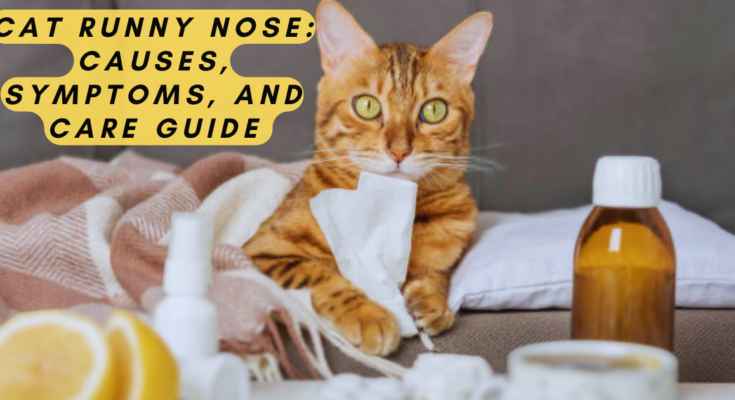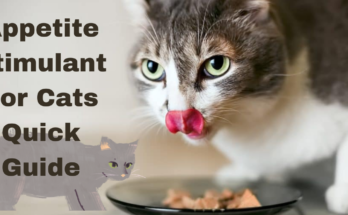Should your cat, Runny Nose, be concerned? It depends on the circumstances. Actually, while there are many simple ways to manage runny noses, they may also sometimes be a sign of more severe health problems. Continue reading to find out what causes cats’ runny noses and when you should bring your pet to the doctor for treatment.
Why Your Cat’s Nose Is Running
Inflammation, damage, or illness of the tissue in your cat’s sinuses or nasal cavities is probably the cause of their runny nose.
However, if your cat constantly has a runny nose, it may be an upper respiratory system infection. The Merck Veterinary Manual states that viruses such as caliciviruses and herpes viruses are the primary cause of respiratory tract infections in cats. The second most frequent cause of runny noses is bacterial infections, such as Bordetella bronchiseptica and Chlamydophila felis. Fortunately, your cat’s chance of acquiring these illnesses is much lower if they have had the appropriate vaccinations.
Apart from common upper respiratory infections, which are usually benign and don’t need medical attention, there are many other reasons your cat’s nose can be running, such as:
Rhinitis: Generally speaking, rhinitis is an inflammation of the passageways in the nose that causes runny noses. Upper respiratory tract infections, viruses, bacteria, and, less often, fungi may all cause rhinitis. Although they’re not a very prevalent cause of rhinitis in cats, allergies are a possibility.
Foreign bodies: A cat may have a runny nose and colorful discharge when they inhale a foreign body, such as a piece of its diet or a single fiber of yarn.
Furthermore,
Fungal Infection:
Cats are susceptible to fungal infections in their nasal canals, which may include Aspergillus and Cryptococcus.
Usually, cats that inhale or come into close touch with fungus spores experience this. Because these illnesses damage cats’ neurological systems, they may cause more than just runny noses. They can also induce behavioral abnormalities.
Nasal cancer: This kind of cancer may be somewhat aggressive in cats. Early symptoms may include a simple runny nose. Still, they may also face puffiness, discomfort, congestion, and thick or colorful discharge.
Trauma: When the swelling goes down, blows to the nose might create a bloody flow that becomes clear. Additionally, nasal discharge from trauma may develop infectious and become greenish-yellow.
Nasal Polyp: Although they may afflict cats of any age, polyps of the nose are most frequent in kittens. Small, benign lumps called polyps form within the nasal passageways. They often result in frequent sneezing and discharge from the nose on the side of the nose containing the polyp.
There are many possible reasons for blood-tinged discharge from the nose in cats, including trauma, elevated blood pressure, toxicity intake, coagulation problems, cancer, and tick-borne infections. Immediately take care of each of these.
Treatment for Runny Nose in Cats
The underlying reason for the nose running determines the course of treatment. Cats must first stabilize when arriving at the veterinarian clinic. For instance, extra oxygen comes immediately if a cat has respiratory problems and generates nasal discharge. If your cat is very ill, you may need to put them in the hospital and provide supporting care. Others might require surgery to address the underlying issue and stop their runny nose.
• Drugs that reduce inflammation, such as prednisolone
• Antibiotics, such as doxycycline or Clavamox®
•medications, which include famciclovir
• Antifungal drugs, such as itraconazole
• Diphenhydramine is one of the antihistamines.
• Supplements in the diet such as L-lysine
• Vitamin K (in the event of a clotting anomaly or toxic exposure)
• Medication for blood pressure (if hypertensive)• Drugs that reduce inflammation, such as prednisolone
• The use of antibiotics such as Clavamox® or doxycycline
• Antibiotics, like famciclovir
• Antifungal drugs, such as itraconazole
• Diphenhydramine is one of the antihistamines.
• Dietary supplements like L-lysine
• Medication for blood pressure (if hypertensive)Drugs that reduce inflammation, such as prednisolone
(In the event of a coagulation anomaly or toxic exposure) Vitamin K
When to Take Your Cat to the Vet
You don’t necessarily need to go straight to the clinic when your cat has a runny nose.
A stuffy nose is usually the consequence of an illness that will go away on its own or is a byproduct of the regular nasal cleaning process. Sneezing, nasal discharge, red, watery eyes, coughing, oral or nasal ulcers, sniffles, fever, and hoarseness are cats’ most typical symptoms of runny noses. To be sure you can get your cat back to feeling well, these specific symptoms, which often follow upper respiratory tract infections, call for a visit to the veterinarian.
Severe eye swelling, red or greenish discharge, excessive fatigue, a high temperature, low appetite, and trouble breathing are other concerning symptoms to watch out for. Cats may experience symptoms from a cold, which can heighten the risk of bronchitis or even cancer due to bronchopneumonia. If you see any of these symptoms, take your cat to the veterinarian immediately. Early intervention may have a significant impact.
Recovery of Runny Nose in Cats
Your cat’s recovery period may vary depending on what is causing the runny nose. Your cat should recover after receiving antibiotics or antifungal medicines if a bacterial or fungal illness is the reason.
Upper respiratory infections normally result in a complete recovery for cats; however, problems may arise throughout the healing process for older or younger cats with other medical issues. Cats who recover from the ailment are still carriers, so they might have a recurrence of the illness in the future.
If you can keep your cat from coming into contact with the allergens, recovery from runny noses caused by allergies typically happens rather quickly. On the other hand, some allergies are seasonal, meaning that contact with pollen or additional environmental variables triggers the response. If that’s the case, you may discuss with your veterinarian the possibility of using antihistamines to treat the responses as required, even while you are unable to stop exposure.
Your cat’s physical recovery may take up to a week if surgery is necessary to remove a polyp or foreign item. After the procedure, your veterinarian will probably need to give him another checkup to make sure everything is recovering correctly.
How to Prevent Runny Noses
Trying to prevent diseases and injuries from happening in the first place is the most excellent approach to keeping your cat from having a runny nose. Cats that live outside are more prone to accidents and infectious diseases. You may lower the hazards significantly by keeping your cat inside. Additionally, ensure your cat has the appropriate vaccinations on time from your veterinarian.
Summary
Runny noses in cats can be caused by inflammation, damage, or illness of the tissue in their sinuses or nasal cavities. Upper respiratory system infections, such as viruses and bacterial infections, are the primary cause of runny noses in cats. Other causes include rhinitis, foreign bodies, fungal infections, nasal cancer, trauma, and polyps. Treatment for runny noses depends on the underlying cause and may include additional oxygen, surgery, medications, dietary supplements, vitamins, and antihistamines.
When taking your cat to the vet, monitoring symptoms such as sneezing, nasal discharge, red, watery eyes, coughing, oral or nasal ulcers, sniffles, fever, and hoarseness is essential. Take your cat to the doctor right away if you see these signs. Recovery from runny noses can vary depending on the cause, but typically, recovery from allergies occurs quickly. Some allergies are seasonal, and if contact with pollen or environmental factors triggers the response, antihistamines may used to treat the reactions.
Physical recovery may take up to a week if surgery is necessary to remove a polyp or foreign item. After the procedure, your veterinarian will likely need to give another checkup to ensure everything is recovering correctly. Preventing runny noses is the best approach to keeping your cat from having one. Keeping your cat indoors and ensuring they have the appropriate vaccinations on time from your veterinarian can help reduce the risks associated with runny noses.





Your articles are extremely helpful to me. Please provide more information!
Thank you so much for taking the time to read my article! I’m thrilled to hear that you found it interesting. If you have any questions or if there’s anything specific you’d like to know more about, feel free to ask. As soon as possible we Provide more information on this topic. Thank you.
Thank you for writing this post. I like the subject too.
you have a terrific weblog here! would you like to make some invite posts on my blog?